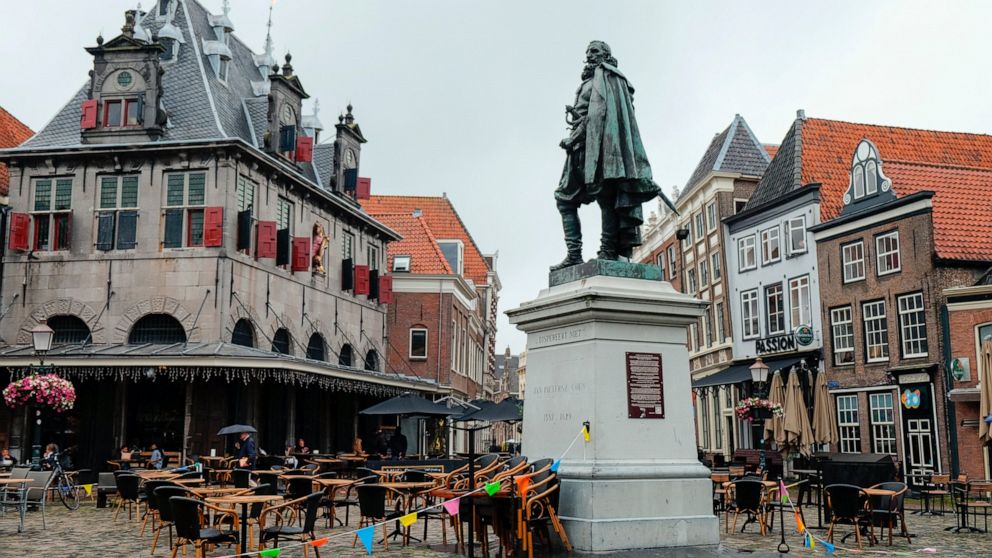The 17th century has long gone down in Dutch historical past as the Golden Age, when unheard of trading wealth helped fund the likes of artists Rembrandt van Rijn and Johannes Vermeer
By
MIKE CORDER Related Press
June 19, 2020, 12: 59 PM
5 min read
AMSTERDAM —
The 17th century has long gone down in Dutch historical past as the Golden Age, when unheard of trading wealth helped fund the likes of artists Rembrandt van Rijn and Johannes Vermeer.
However the grim flip side of the prosperity — fortunes generated by seafaring traders, slavery and iron-fisted colonial rulers — is being brought into keen focal level amid world protests sparked by the killing of George Floyd.
Activists spurred by the Gloomy Lives Topic protests within the US are searching for to shed extra light on the Dutch colonial past and take care of what they name ingrained racism and discrimination within the Netherlands, a nation that was as soon as is known as a beacon of tolerance.
Essentially the newest procedure of activists is a statue of a top officer of the Dutch East India Company who within the 17th century primarily based the metropolis that is now Indonesia’s capital, Jakarta. Protests calling for the elimination of the statue of Jan Pieterszoon Coen and a counter-demonstration supporting it are planned for Friday evening.
Honored since the slack 19th century as a colonial ruler and main light within the Dutch East India Company trading powerhouse, Coen furthermore is reviled as the “butcher of Banda” for a bloody 1621 assault on a neighborhood of islands in expose to salvage a monopoly on spices grown there. Thousands of island inhabitants had been killed.
“He’s a murderer, and we shouldn’t … occupy murderers on a statue. That’s no longer completed,” Marisella de Cuba, one of many allege organizers, talked about.
“In phrases of J.P. Coen, they’re blind to the trouble of of us,” added De Cuba, who was born on the Caribbean island of Aruba and has lived within the Netherlands for years.
Karwan Fatah-Gloomy, a historian and lecturer at Leiden College, thinks the many protests within the Netherlands within the wake of Floyd’s death on the hands of Minneapolis law enforcement officials on May perchance presumably perchance 25 are a response to the voices of migrants and descendants of of us from musty Dutch colonies being marginalized in Dutch society.
“Their concerns had been continually pushed apart for a truly prolonged time,” Fatah-Gloomy talked about. Amongst the concerns he listed: Racial profiling by police and tax authorities, discrimination in locations of work, colleges and on the housing rental market, and instances of police brutality.
The demonstration, discipline to happen in Coen’s fatherland of Hoorn, follows protests across the Netherlands in recent weeks against police violence and racism, in conjunction with two in Amsterdam that drew hundreds of participants. A statue of Piet Hein, a colonial generation mariner widely understanding to be a hero, was daubed with crimson paint and the note “killer” remaining week.
Prof. Remco Raben, who teaches Dutch colonial and post-colonial historical past on the College of Amsterdam, talked about the protests focusing on statues are “a produce of correction of the imaginative and prescient of the nation because it emerged within the 19th century and no longer as a rewriting of the historical past. It’s the rewriting of the image of the nation.”
“That’s the set it ties in with the post-colonial communities within the Netherlands, due to they stumble on that they are no longer supplied within the final public, political sphere, … so that they question for correction of that,” Raben talked about.
But there are silent a complete lot of of us within the Netherlands who reject this kind of reevaluation of the past.
Populist lawmaker Thierry Baudet lately laid a bunch of roses on the deplorable of the Coen statue in Hoorn, asserting in a video posted on Twitter that he was honoring the Dutch identity and historical past. The brief-rising Dialogue board for Democracy occasion that Baudet leads is the usage of the protests as a rallying bawl to recruit new participants.
In the Netherlands, it is no longer handiest statues that occupy ties to slavery and oppression. Across the country, streets undergo the names of Golden Age figures. The wealth of 17th-century traders funded stately mansions that silent stand on Amsterdam’s canals.
The horse-drawn Golden Carriage, on the moment undergoing a prolonged restoration but historically liable to support the Dutch monarch to the articulate opening of Parliament per annum, furthermore is getting a reassessment. One in every of its panels is decorated with a painting depicting Africans and Asians carrying items to indicate to their colonial masters.
As of late, phenomenal of the polarized Dutch debate about trot has revolved across the divisive young of us’s personality Gloomy Pete, who’s on the total portrayed by white of us sporting blackface makeup at celebrations each and each December marking Sinterklaas, a Dutch occasion of St. Nicholas.
Activist De Cuba talked about she hopes that protests inspired by Gloomy Lives Topic will furthermore take care of Gloomy Pete this three hundred and sixty five days.
“I like of us are waking up and I hope, I no doubt hope, it’s no longer like a hype and that all americans who’s standing at a Gloomy Lives Topic allege will expose up furthermore in November when we’re protesting Gloomy Pete and can expose up every time when we’re addressing the project of racism in this country,” she talked about.
